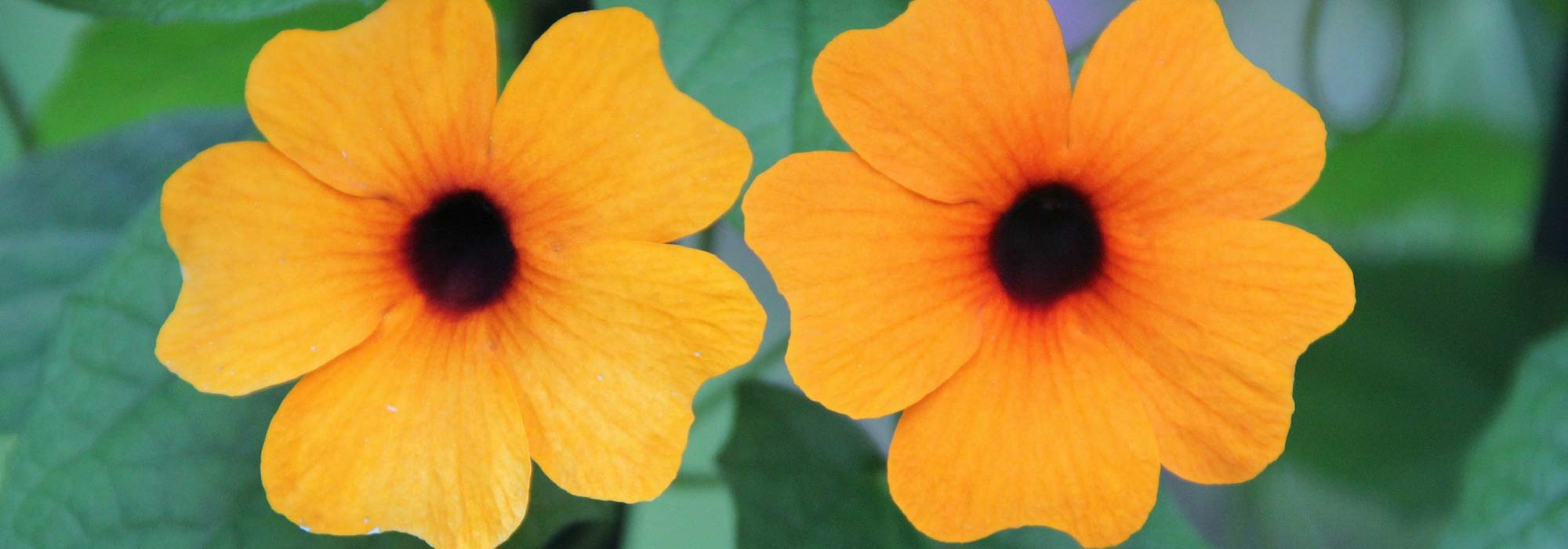
Black-eyed Susan: sowing, planting, and caring for it
Contents
Black-eyed Susan in a nutshell
- This very floriferous climbing plant, with rapid growth, adorns any support provided to it within weeks, from June to October.
- It adds a touch of exoticism with its intense summer flowering in yellow-orange with a black eye.
- Of tropical origin, this frost-sensitive perennial, which freezes below 8°C, is grown as an annual in our regions, either in the ground or in pots that need to be brought indoors during winter.
- This sun-loving climber fears only frost and thrives in any fertile soil in a well-sheltered spot.
- Highly voluble, it is ideal as a trained climber on supports like trellises or fences, as a large groundcover, in pots, or in stunning hanging displays from which it will elegantly cascade with leaves and flowers.
A word from our expert
The Thunbergia, more poetically known as “Black-eyed Susan”, is a remarkable climbing plant celebrated for its vibrant flowers, typically orange with a black centre, which are quite unique.
When grown in our climates, it is most often cultivated as an annual or in pots, sheltered from the harshness of winter, kept warm in a greenhouse or on a veranda. Its flowering lasts from May until the first frosts, and its rapid growth makes it an excellent choice for a climbing plant.
This beautiful ornamental climber is perfect for greenhouses or gardens in summer! Its intrepid stems cling to anything within reach, quickly transforming even the simplest support into a very floriferous display.
Exuberant, the Black-eyed Susan can reach a height of 2 m in just one season!
In addition to the traditional Thunbergia alata orange (‘Superstar orange’), there are blue Thunbergia such as Thunbergia grandiflora and white Thunbergia (‘Alba’).

The “Black-eyed Susan” is a highly floriferous annual.
With its numerous trumpet-shaped flowers, this voluble annual with gourmet, vibrant hues and lush foliage will entwine all summer around your pergolas, trellises, and fences, weave around shrubs, or even form a large groundcover. You can also grow it in pots or in stunning hanging baskets where it will create an elegant trailing effect.
With its exotic appearance, it is an easy plant to grow as long as it is exposed to sunlight and sheltered from cold drafts. Little susceptible to diseases, the Black-eyed Susan requires very little maintenance, fearing only frost.
From cuttings to sowing, discover our collection as well as our beautiful selection of Black-eyed Susan seeds, this beautiful climbing flower that adds an essential touch of originality in summer!
Description and Botany
“`html
Botanical data
- Latin name Thunbergia
- Family Acanthaceae
- Common name Black-eyed Susan, Eye of Susan
- Flowering from May to autumn
- Height 0.60 to 5 m
- Exposure Sun, partial shade
- Soil type All, well-drained
- Hardiness +8°C
Thunbergia, more poetically known as “Black-eyed Susan” or also “Eye of Susan” or “Zanzibar Smile,” is a climbing and voluble plant from the Acanthaceae family, native to the tropical regions of East and Southern Africa, Madagascar, and India. In its natural state, it grows in forests, on rocky walls, wrapping around trees or bushes.
It has naturalised in many countries including Australia, Haiti, and Florida, where it is considered an invasive perennial.
From its tropical and subtropical origins, it retains a certain sensitivity (hardiness between 10 and 8°C), and is grown as an annual or kept protected from frost in winter in our climates.
The genus Thunbergia comprises about 100 annual or perennial species with evergreen foliage, climbing or bushy, including Thunbergia alata with orange to yellow flowers and Thunbergia grandiflora (or Bengal Trumpet) with dark blue flowers, which are the most commonly cultivated. The latter comes in several cultivars, including Thunbergia grandiflora ‘Alba’ with white flowers. Less commonly, Thunbergia erecta is a bushy species with blue-violet flowers and a yellow throat, or T. gibsonii with bright orange flowers.
With its climbing habit, this fast-growing liana can form a beautiful bush up to 2 meters high in all directions in just one summer, sometimes more. The heights of the plant are very variable. In its natural habitat, Thunbergia can reach up to 12 m high (Thunbergia grandiflora), much less so in our latitudes. The tallest woody specimens can live for several years in a greenhouse during the cold season, becoming grandiose and reaching several meters for container-grown plants.
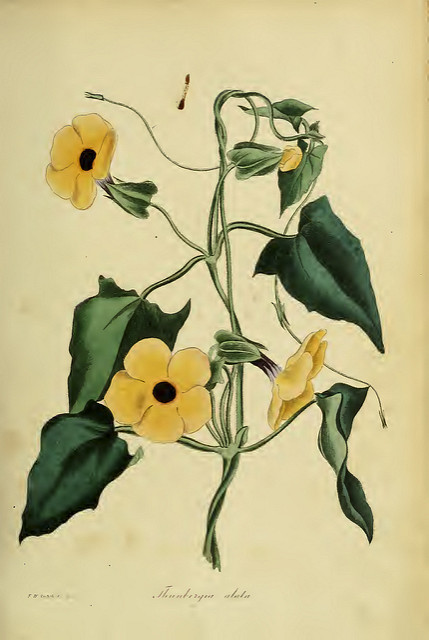
Thunbergia alata – botanical illustration
From a woody stump, Thunbergia develops on voluble stems that climb by wrapping around any support using the petioles of the leaves. Hairy, thin, and quadrangular, sometimes purplish, they cling on their own until they intertwine, forming a beautiful mass. They lignify over time.
On these stems, the lush foliage, bright green to dark green, develops. It remains evergreen when the plant is wintered away from frost. It consists of opposite leaves, entire or lobed and serrated, up to 20 cm long and 15 cm wide. Rough and downy, they are heart-shaped with sagittate tips and measure between 2.5 and 20 cm long. In the alata species (winged), they are borne on a slender winged petiole at the base of two small leaves, which gave the plant its specific name.
Particularly graphic, these long leafy stems add a certain lushness to the plant and highlight the exotic colours and voluptuous shapes of the flowers. Thunbergia is appreciated for its original and long-lasting flowering that extends from June to the first frosts. Black-eyed Susan is one of the most spectacular vines for the beautiful season. The bushy vegetation is adorned with a profusion of large trumpets.
The flowers, encased in a hairy calyx and suspended by a short peduncle, bloom all summer long, continuously, either solitary or in small groups at the axil of the leaves, all along the stems. Around a small dark purple eye resembling a pupil at the centre of an iris, which earned it the nickname “Black-eyed Susan,” each petal opens in various often vibrant colours.
The tubular flowers, measuring 2 to 8 cm, open into five spreading lobes of golden yellow, yellow-orange, sulphur yellow, orange, brick red, cream yellow, most often, but less commonly white or even lilac blue (Thunbergia grandiflora) or blue-violet (Thunbergia erecta) with a throat marked in brown or yellow. Thunbergia ‘Tangerine Slice’ is distinguished by its bicolour shade and the unusual pattern of its red-orange flowers striped with mustard yellow. The Thunbergia grandiflora or Thunbergia with large flowers bears the largest flowers (6 to 8 cm in diameter).
Nectariferous, this aubergine purple eye almost black at the centre attracts pollinating insects. After pollination, in warm climates only, the flowers develop into fruits, globular capsules that catapult small round seeds over a distance.
Black-eyed Susan is usually grown in our country as an annual in open ground or in pots as a houseplant due to its fragility and low hardiness (-8°C) against frost. If you want to keep it: bring it in!

Thunbergia, several flower colours.
Easy to cultivate, this tropical perennial needs heat, light, water, and a light, draining, humus-bearing soil to thrive. To bloom well, it will appreciate a sunny or shaded position protected from winds and cold drafts.
Black-eyed Susan grows very quickly and dresses a trellis, a pergola, a lattice, or a pyramid stake in the middle of a summer bed in just a few weeks. Untrained, it can also form an original groundcover at the foot of shrubs.
Grown in pots, in hanging baskets or window boxes, it flowers terraces and balconies. It can also find a place in the conservatory where it will thrive in warmth.
“`
Main species and varieties
The genus Thunbergia comprises around a hundred climbing species, with Thunbergia alata being the most commonly cultivated, featuring trumpet-shaped flowers punctuated by a distinctive black eye that come in all shades of yellow and orange.
Occasionally, Thunbergia grandiflora (or Bengal trumpet) can also be found, boasting dark blue flowers that are available in several cultivars, including Thunbergia grandiflora ‘Alba’ with white flowers. The main criteria for selecting these floriferous climbing plants are the flower colour. A must-have in the garden as an annual or year-round in a warm greenhouse!
Thunbergia alata Tangerine - Black-eyed Susan
- Flowering time July to November
- Height at maturity 2 m

Thunbergia alata - Black-eyed Susan Vine Superstar Orange Seeds
- Flowering time July to October
- Height at maturity 2 m
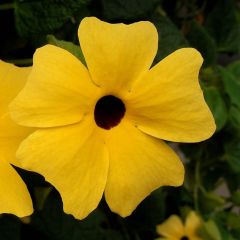
Thunbergia alata
- Flowering time August to November
- Height at maturity 2 m
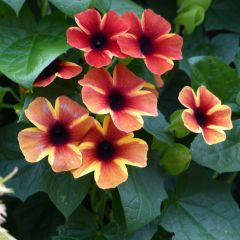
Thunbergia Tangerine Slice - Black-Eyed-Susan
- Flowering time July to November
- Height at maturity 2 m
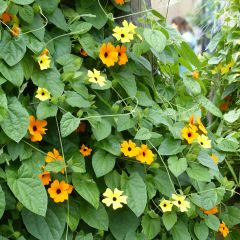
Thunbergia alata Collection - Black-eyed Susans
- Flowering time July to November
- Height at maturity 2 m
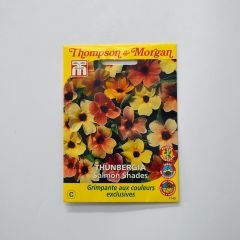
Thunbergia alata - Black-eyed Susan Vine Salmon Shades
- Flowering time July to October
- Height at maturity 1,50 m
Discover other Thunbergia
View all →Available in 1 sizes
Available in 1 sizes
Available in 0 sizes
Available in 0 sizes
Available in 1 sizes
Available in 1 sizes
Sowing and planting
Where to Plant Black-Eyed Susan
The Black-Eyed Susan is sensitive to cold and frost is fatal to it. It is a tropical plant suited to warm climates that does not tolerate frost. It cannot withstand temperatures below 8°C, which is why, in our climates, it is usually grown as an annual in the ground or potted and brought indoors to protect it from frost during winter. In October, before the first frosts, move the pots to a bright, warm place (the temperature should be above 10°C to preserve its beautiful foliage). You can take them outside during the lovely season.
It requires full sun to bloom well. In the south of our country, it will fear overly hot sun and will accept partial shade to protect it from the scorching midday rays.
This beautiful perennial climbing plant grows quickly and should be planted in light, rich, and well-draining soil. In fertile, cool soil, its growth will be enhanced, and its flowering will be very abundant.
The Black-Eyed Susan can reach 2 m in the space of a summer. The height of the plant is quite variable: ensure you have an appropriate support and enough space. It needs to be trained or staked if you are using it as a climber.
This remarkable climber is easy to grow, whether in the ground or in pots on the terrace or in a greenhouse.
It can be used in borders or as a standalone, left to itself in a warm spot or trained on a trellis or fence, a tipi, a pergola, a railing, or a pyramid stake. It can even weave around bushes or abundantly cover walls.
Its continuous flowering from May to the first frosts makes it an excellent choice for quickly flowering large, lush pots or stunning hanging baskets that can be kept on the balcony all summer or in the conservatory where it can thrive in warmth during winter.
When not guided on a support or staked, in the garden, it can also form an elegant bushy and trailing mass over a low wall or a unique groundcover at the foot of shrubs.
When to Plant and Sow Thunbergia or Black-Eyed Susan
Plant the plug plants in the ground, strictly when the risk of frost has passed, during the month of May. Seeds can be sown in a warm place, starting in March, in pots or trays. You can also sow directly in the ground from April to June.
How to Plant and Sow Black-Eyed Susan
- Planting in the Ground
Upon receipt, pot up and store our young plug plants of Black-Eyed Susan in a sheltered, warm, and bright place (conservatory, greenhouse, cold frame…) at a temperature above 14°C for a few weeks. Once the risk of frost is definitely over, plant them in the ground outdoors.
Install 2 to 3 Black-Eyed Susan plants per m², approximately every 30 cm.
Provide it with a trellis or a stake at planting around which it can entwine. If your garden soil is too poor, enrich it with potting soil and compost.
- Dig a hole three times wider than the root ball
- Make a good gravel bed to ensure perfect drainage
- Place the plug plant in the centre of the hole, with the collar level with the soil
- Bring back the excavated soil mixed with potting soil to encase the roots
- Firm down with your foot
- Water regularly
- Sowing
In Pots:
- Soak the seeds before sowing
- From late February to March, under cover at a temperature of 18-20°C, sow two to three seeds in 6 cm pots in a light mix of equal parts peat and sand
- Only bury the seeds to a depth of 1 cm
- Firm down and maintain at 20°C in sunlight until germination (between 14 and 21 days)
- Three to five weeks later, separate the seedlings and pot them into individual 12 cm pots placed under cover
- In May, when the soil is warmed and the risk of frost has passed, plant the seedlings in the garden or in pots or containers of 20 cm in diameter (larger for taller varieties) in soil enriched with compost
- Immediately provide them with a support to wrap around
In the Ground:
You can also sow directly in place, in warmed soil during the months of April to June, at a rate of 2 or 3 Thunbergia seeds per cluster every 30 cm. Stake or let them sprawl on the ground. Feel free to mix different varieties together to create warm, colourful displays.
- Pot Culture
All Black-Eyed Susans are suitable for growing in large pots or hanging baskets (the trick to avoid having to stake the beautiful climber!). They can be taken outside in the lovely season and brought back in as soon as the first frosts arrive, or kept in a conservatory warm all year round.
- Plant in a rich, well-draining mix consisting of 1/3 potting soil, 1/3 river sand, and 1/3 garden soil
- You can also add a bit of compost
- Mulch generously at the base to retain moisture
- Stake if necessary
- Water generously, keeping the substrate always slightly moist
- Fertilise regularly
- Place in light, without direct sunlight to preserve its colours
- In autumn, bring the pots into the conservatory to protect them from frost
→ Learn more about growing Black-Eyed Susan in pots with Leïla’s tips.
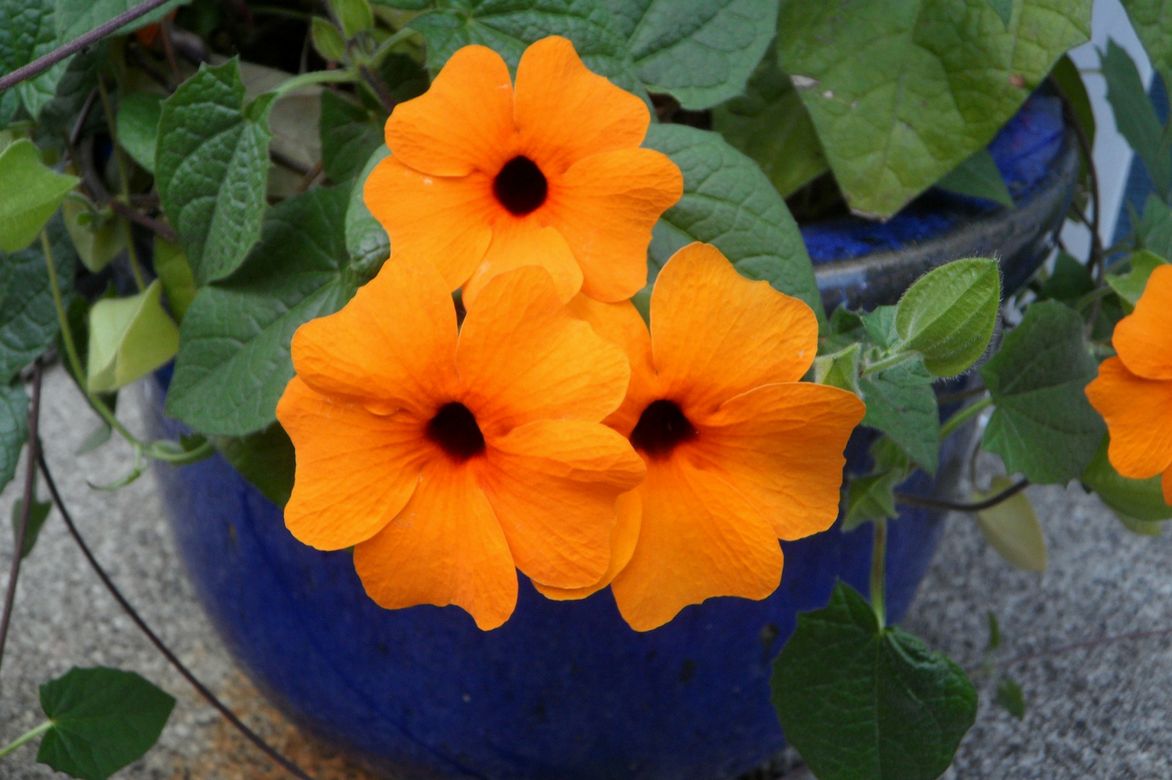
Black-Eyed Susan is well-suited for pot culture.
Read also
Planting annualsMaintenance and Care
Peu contraignante, la Black-eyed Susan demande vraiment little maintenance, ne craignant que le gel. Elle demande juste à être protégée du froid. Elle se révèle easy to grow après une installation soignée, pour peu qu’elle ne manque ni de nourriture, ni d’eau, ni de soleil, car this sensitive plant loves warmth!
Pensez à stake your plants dès leur installation en pleine terre comme en pot.
En été, maintenez le sol frais, surtout en cas de sécheresse prolongée. Il est préférable de mulch generously le pied dès la plantation : elle supportera assez bien une courte sécheresse, pourvu qu’on l‘arrose régulièrement lors des grosses chaleurs estivales.
Dès novembre, arrachez les Black-eyed Susans qui sont plantées dehors.
In pots
Si nécessaire plantez un tuteur au centre du pot pour faciliter l’enroulement des lianes.
La Black-eyed Susan est gourmande. Pendant toute la durée de la croissance, apply fertiliser for flowering plants every 15 days.
Water generously dès la motte s’assèche, en maintenant la terre toujours un peu humide.
En hiver, espacez les arrosages en laissant la terre se dessécher entre deux arrosages.
Dès le mois d’octobre, à l’approche de l’hiver, bring in the Thunbergia grown in pots to a very bright place and not too cold, sheltered from frost, in a greenhouse or a conservatory where the temperature does not drop below 10°C.
Pruning the Black-eyed Susan
Eliminez régulièrement les fleurs fanées, cela favorisera le renouvellement de la floraison.
En août, si votre thunbergia perd un peu de vigueur, lightly prune the stems, it will grow back stronger.
La taille ne se pratique véritablement que sur les plantes hivernées ou cultivées à l’intérieur et dont la durée de vie est de ce fait allongée. On parle davantage de annual thinning pruning. Celle-ci permet d’équilibrer ou de réduire la ramure, de revitalise the stems et de favoriser croissance et floraison. Elle peut s’avérer également utile si votre Thunbergia devient envahissant : il faut parfois contenir sa croissance !
- En septembre, avant de les rentrer au chaud ou between February and March, avant la reprise, avec un sécateur, remove the intertwined, weak or dead stems at their base, keeping only the strongest, cut the spent shoots
- Vous pouvez également rabattre un peu la touffe
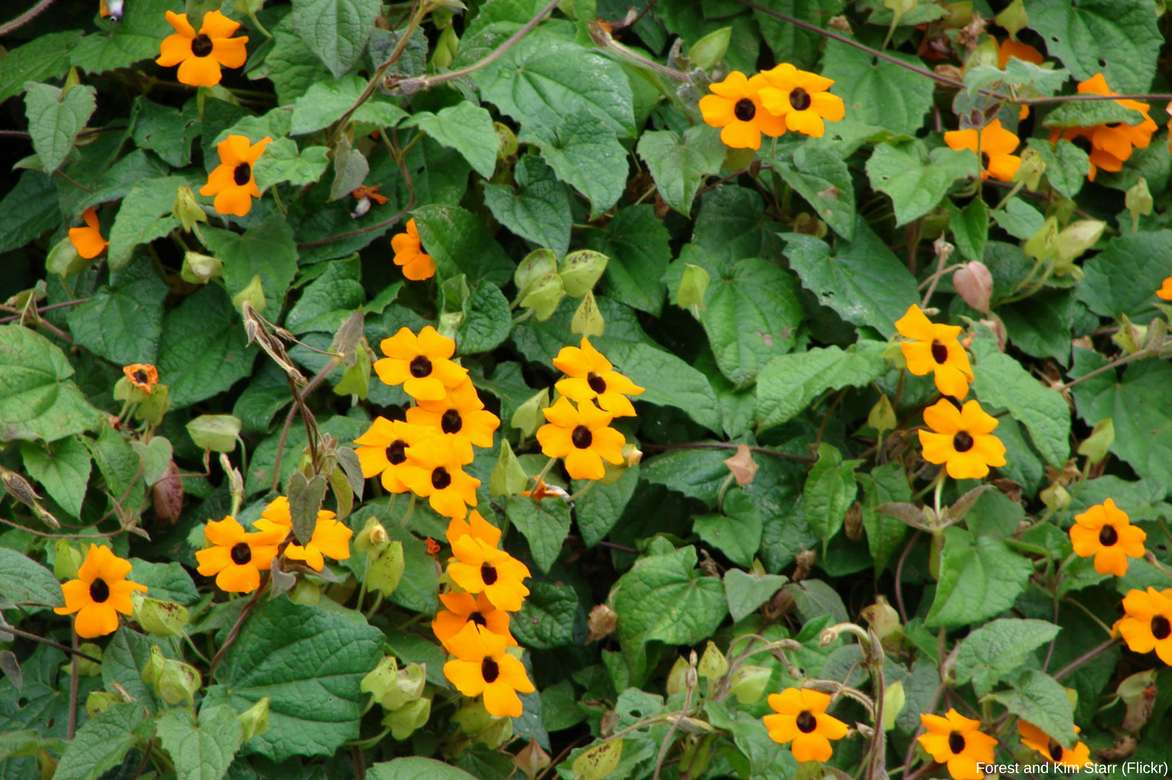
Flowers of Thunbergia or “Black-eyed Susan”.
Pests and potential diseases
In open ground, Black-eyed Susan has no enemies; only plants grown in greenhouses may be more susceptible to infestations of mealybugs, whiteflies, or red spider mites.
Mealybugs can be eliminated with a cotton ball soaked in 90°C alcohol, followed by rapeseed oil sprays to be repeated two or three times at 15-day intervals.
To eliminate whiteflies, spray a soapy solution made from black soap mixed with a bit of vegetable oil.
Against red spider mites, which are common when the plant lacks water, spray a nettle maceration.
Powdery mildew sometimes whitens its foliage in cases of excess moisture: spray decoctions of horsetail or nettle manure.
Multiplication
How to propagate Black-eyed Susan cuttings?
This method can be somewhat hit or miss. However, it is worthwhile to take cuttings of Thunbergia as after two years of indoor cultivation, the plant tends to flower less.
- In August-September, take semi-woody cuttings (turning into wood), 10 to 15 cm long just below a node
- Remove the leaves at the bottom of the stem and take off the flowers
- Dip in plant hormone
- Insert them three-quarters into individual pots filled with a light (turf and river sand) and well-draining mix, kept moist but not soggy
- Place under a warm frame (18°-25°) during winter, in light but out of direct sunlight under a bell or plastic
- Repot into 10 cm pots
- Transplant them outdoors in spring, in May when they have enough roots and the soil is warm enough
Associate
The Black-eyed Susan is a stunning climbing voluble plant with warm, vibrant colours that adapts to all desires, whether in the ground or in pots. Within a few weeks, it dresses any support provided with a touch of exoticism, adding a whimsical flair to somewhat rigid flower beds.
Its always vibrant hues are essential in summer for all flower beds or containers, pairing well with plants in warm colours.
When left to its own devices, it will create a lush carpet at the base of bushes alongside the pretty red, elongated flowers of a Nasturtium.
You can find it in our summer perennial plants alongside the large tomato-red or fiery orange flowers of Echinacea, the large daisy-like flowers in a beautiful intense red of Helenium, or even gladioli around which it will twine. Meanwhile, some Grasses like Calamagrostis will temper the display with their golden hues.
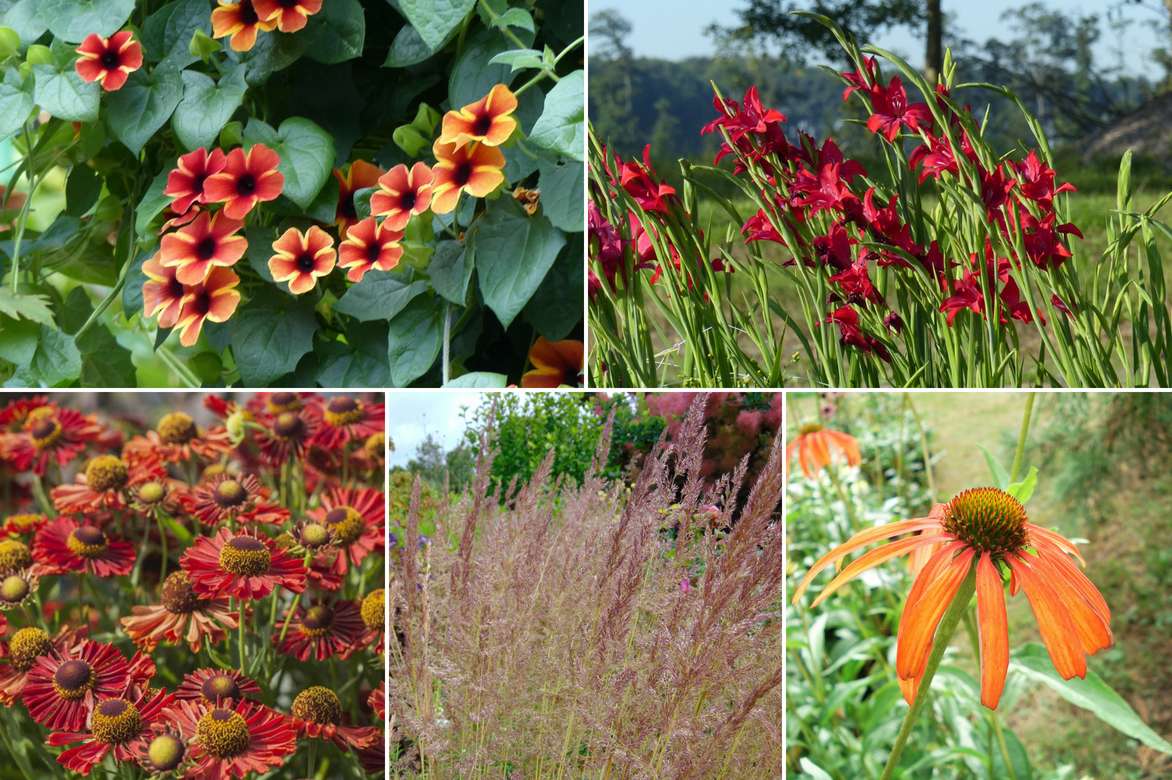
An example of a warm-toned association: Thunbergia ‘Tangerine Slice’, Gladiolus ‘Robinetta’, Helenium ‘Ranchera’, Calamagrostis acutiflora ‘Avalanche’, Echinacea ‘Tomato Soup’.
The Thunbergia easily associates in a shrub bed with a variety of flowering shrubs for mild climates, featuring the red blooms of Oleanders, the Dwarf Pomegranate, or the sky-blue of a Cape Fuchsia.
Its unique flowering will echo the trumpet-shaped mandarin flowers of a Campsis radicans or Trumpet Vine or another herbaceous climber like a herbaceous clematis.
It will also make a striking impact in a hanging basket or a large pot alongside petunias, ivy geraniums, Lobularia (or Sweet Alyssum), or Mandevilla.
Pair it with marigolds, gauras, or sages that will keep the soil cool at its base.
→ Discover more association ideas with the Black-eyed Susan in our advice sheet!
Useful resources
- The best black-eyed Susan seeds are with us!
- Discover our tips for sowing black-eyed Susan.
- Having beautiful summer or spring planters that are original and long-flowering is possible and even easier than it seems with our annual flower plug plants!
- Have you just bought our black-eyed Susan plug plants? Discover on our blog how to plant and care for these beautiful annuals.
- Do your plants seem sick? Find out how to help them in our advice sheet: Diseases and pests of black-eyed Susan.
Frequently asked questions
-
How to harvest black-eyed Susan seeds?
Thunbergia, or Black-eyed Susan, only fruits in warm climates, making it quite rare to see this happen in our gardens. However, potted specimens kept warm indoors may, after flowering, develop flowers that turn into small globular capsules hidden between two green bracts. Allow the capsule to dry on the plant, but harvest the seeds before it bursts, catapulting the small round seeds far away; you will then have a hard time retrieving them!
- Subscribe!
- Contents
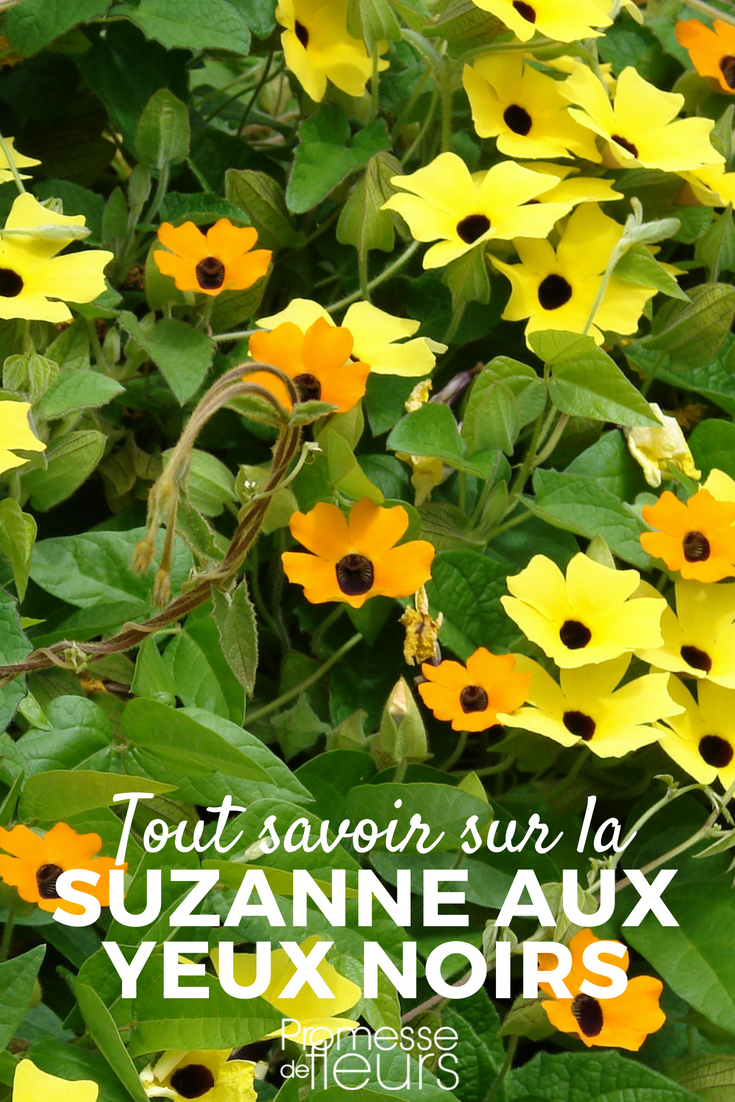































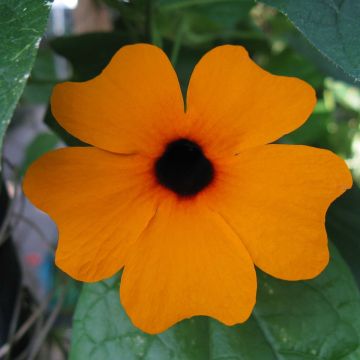


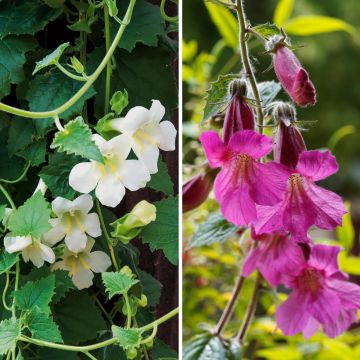
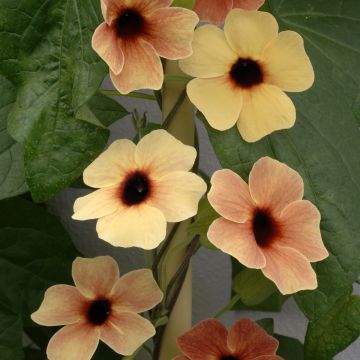

Comments